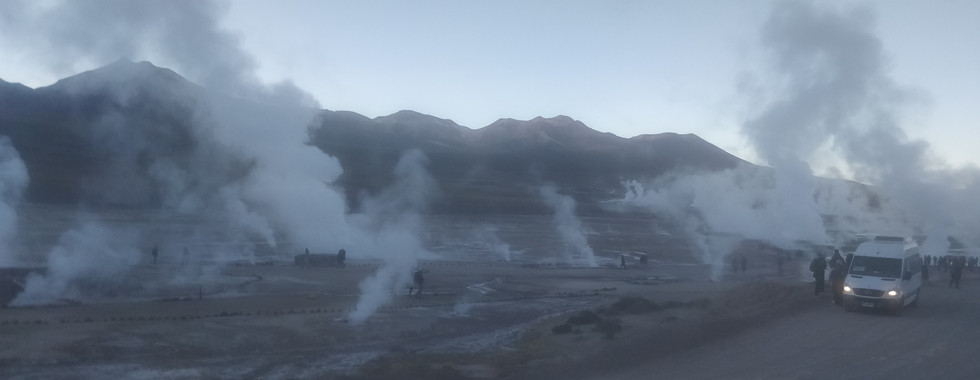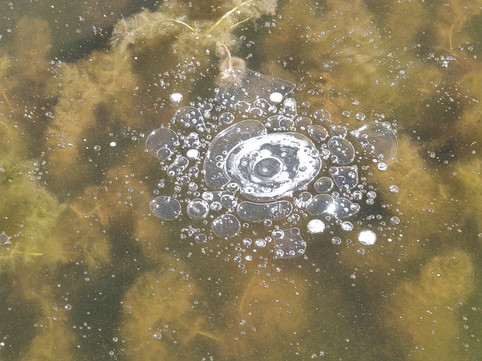Atacama- The driest place on Earth
- sonal parakh

- Aug 24, 2020
- 10 min read
As a child, did you want to be an astronaut?
Did you ever look up at the the night sky, wondering at the shiny celestial objects and wished to wake up into one of these extraterrestrial landscapes.
I can almost hear you scream... Oh My God! YES!
Well, I have some good news for you. There is a place, right here, on our very own planet, somewhere in Chile that is as unearthly as it can get. So much so, that it legitimately has valleys named as Valle de la Luna (Moon Valley) and Valle de Marte (Mars valley).
This place is also the driest place on Earth, the Atacama desert in Chile, close to a small quaint town, San Pedro de Atacama. Surprisingly, it receives only 7-9 days of rainfall in the whole year. With landscapes ranging from snow capped mountains, lagoons with turquoise blue waters, hot water springs, Geysers, colorful lakes, cactus higher than yourself, clear night skies shimmering with a billion stars; every corner of this particular part of the World is definitely full of surprises.
How to reach:
The nearest airport is at Calama, 98 kms away from San Pedro De Atacama. So, we took a flight from Santiago to Calama and then a taxi.
Where to stay:
This is a place that thrives only on tourism. There are lots of cute hostels and guest houses. We stayed in an eco-resort called Domos Los Abuelos. Their rooms are cozy little mud domes that definitely give you the feeling of staying in a desert. The toilets are shared though and could be a bit away from your room, depending on which dome you get. Though this property is tucked a bit away from the town, which is great if you are looking for quite relaxed evenings, the town is only a ten minute walk from here. You will find many more stay options in the town center which is really the center of all tourist activities.
What to do:
There is a whole plethora of places to explore in the Atacama desert. Most destinations are a bit far away and difficult to reach by yourself. You can consider renting a car, which is quite expensive. The tour companies run daily tours to most of these places, and we found that to be the simplest and easiest way to traverse around, given that we had only 3 days in Atacama.
Day 1:
We had breakfast at the resort itself and were picked up early in the morning by the tour operators. After driving around 30 km North, we reached our first stop for the day, Termas De Puritama, or Puritama hot springs.
These hot springs are super fun and exciting. Located amidst absolutely stunning natural surroundings, there are a series of eight stepped pools of geothermal hot spring water. The water is sulfuric which is said to attribute to its medicinal properties and the temperatures ranging between 25° to 32°, rise by a degree as you step from one pool to another. Due to this, heading from one pool to another actually makes for a very interesting experience. The pools connected by wooden pathways, are surrounded by large boulders and natural wilderness. The beautiful landscape around, the sound of the flowing water, and the feel of the warm water on your skin; a visit to these hot water springs is a definite treat to all your senses.
After spending a good couple of hours bathing and relaxing in the hot water springs, we moved onto our next destination, another place full of magic. Laguna Cejar is a lagoon with deep turquoise water, and white shore made of sand crystals, but its most magical characteristic is its water in which you naturally float. Yes ! It is true. you can not drown in these waters. Owing to its high concentration of salt, it allows anyone to float on its surface absolutely effortlessly. Also, the water is nice and warm all year round. So, getting into the waters and swimming is an absolute must here. Staying afloat on the dazzling water truly felt like magic. At first it felt really funny, and later as I got comfortable with the idea, it just made me really happy. The salt makes beautiful patterns on the periphery which are easily visible through the crystal clear water of the lagoon. There are some showers and changing rooms also available here for a quick clean up. You wouldn't want to be tasting salty for the rest of the day.
From here, we continued to The Salt Flat Eyes. These are two mysterious fresh water ponds right in the middle of the driest desert in the world. No one knows what feeds water into these ponds.

Our last stop for the tour was Tebinquinche Lagoon. Such a dramatic landscape, made perfect by a combination of water, sand, salt, setting sun and the Andes. We enjoyed one of the most gorgeous sunsets we have witnessed, with some snacks, music and each other.



Day2:
For the second day of our stay in Atacama, we had booked a tour for Geyser El tatio. It is located at an altitude of over 14000 ft above sea level and get as cold as -13° C. It is therefore suggested to avoid on the first day, so that you get some time to acclimatize. We left really early in the morning to be able to reach there well before sunrise.
The El Tatio geyser field is the highest in the world and with more than 80 geysers, makes up the 3rd largest geyser field in the world. It is a spectacular sight. Just around sunrise, you start hearing fuming and gurgling sounds, and soon enough you would witness towers of swirling steam rising from the ground, sometimes with a fountain of hot water shooting high up into the skies. In a matter of a few minutes, the whole vast expanse of land around you changes into a field of high columns of rising steam taking all possible forms and shapes, and sounds of hissing, bubbling and fuming start coming from all around you. Witnessing this exquisite show by nature of more than 80 geysers and hundreds of fumaroles (the hissing steam from the geysers) spew hot water and steam meters high into the air is an experience of a lifetime. The bubbling mud-pools, hissing geysers and steaming fumaroles ringed by Volcanoes on all sides, is a stunning sight to behold.
You have to be really cautious while wandering around these geysers. Although, all the geysers and fumaroles are well marked and caution lines are drawn, yet there have been some terrible accidents in the past. It is now mandatory to visit with a guide.
On our way back from the El Tatio, we stopped at the Machuca, a small desert village of only 20 houses. There is a tiny church which is beautiful and a lagoon where flamingos can be spotted. We were specially intrigued by weird formations that seemed to be some sort of mineral deposits on the water surface.
We were back in San Pedro by afternoon. Morning was so cold in El Ttaio that I was covered in 5 layers of clothes, and just few hours later, it was so hot, with bright sunlight in San Pedro that I was back in my shorts and tank top.

We strolled around the town lazily trying to find some nice vegetarian food. We also visited the bus station, which I must say is a remarkably beautiful piece of architecture. Built in bamboo, it creates such interesting play of light and shadows. There are some shops from local artisans and a cafe as well. We booked our bus for the next day and left for our evening tour to Valley de Luna (Moon Valley) and Valley de Marte (Mars Valley).
The moon and the Mars valley get their names because of their extraterrestrial geography and otherworldly landscape. Wind and water erosion over thousands and thousands of years have molded the salt, sand and clay into strange formations that give an impression of being on the surface of the Moon and the Mars.
The Moon and the Mars Valley are very close to each other, and are characterized by peculiar rocky formations, sand dunes, caves, petrified sand and salt structures. We first stopped at the salt caves. Impressive rocky caves, that had a very unique texture and formation. There were white deposits of salt and minerals at places. As we kept making our way through narrow tunnels, we kept marveling at these beautiful, intricate structures. As if flowing water had suddenly frozen for centuries. It was incredible to see the beautiful salt crystals from so close, glistening brightly in our torchlight. Once out of the caves, we simply sat on the jagged rocks and appreciated the browns and yellows of the rocks against the deep blue sky.
Moving a little further, we came across a strange rocky formation, popularly known as Las Tres Maria, because it resembles three women. We also walked past a naturally occurring cliff formation in the form of an amphitheater.
Next, we did a short hike with the rocky martian landscape on one side and a sand dune on the other to reach another vantage point that blessed us with amazing views of the valley. The last but the best part of the trip was watching the sun set over this unearthly valley. The changing colors of the valley and of the sky, the rocky structures beneath being taken over by shadows, and the quickly dropping temperature, such a delightful drama unfolding right in front of our gleaming eyes, a sunset I will always remember.


Day 3:
Last day in Atacama, we wanted to make the best of it. We took a tour for Salar de Tara with Vive Atacama, which started in the morning and we were back by late afternoon.
Salar de Tara is a huge salt flat located within the Los Flamencos National Reserve of Northern Chile, at the foothills of a series of volcanoes and offers magnificent views. Though we were supposed to visit Salar de Uyuni next, we couldn't resist the temptation of visiting this one after looking at the drool-worthy pictures of its tinted lake, the flamingos and the bizarre rock formations. And, I must confess, it did not disappoint at all.
We made a few stops on the way to the Salar. The first one was at Quepiaco Bofedal which is a unique wetland ecosystem with diverse flora and fauna. The yellow shrubs in blue water against a backdrop of the red mountains made for a picture perfect landscape. One can spot a lot of birds here. We also spotted few Vicunas and an Andean fox just as we were leaving from here.
Next, we stopped to appreciate the giant rock spires standing upright in the middle of the desert. These geological formations known as Monjes de la Pacana or the Pecan monks are actually volcanic sediments eroded by the action of wind and water over thousands of years making them look like giant monks that guard the place.
These rock sculptures are great to do photography with, the vast desert that they sit on and the reddish hills at the back add to the drama. After spending a hearty time here, we headed to Salar De Tara. As we walked towards the lake, we came across a mighty rock formation, like a giant wall with columns and spires. Rightly so, this is known as 'the Cathedral', Really, nature is the biggest architect of all times. On one side was the Cathedral, and on the other, such a magnificent landscape. The ground was all dusted with white salt, and contrasted beautifully with the yellow and green bushy vegetation, the sky was bright blue with cotton clouds hovering all over, the mystic red rocky formations and the snow capped peaks in the distance made for an excellent backdrop and the lake, looked absolutely surreal, tinted with multiple hues and dotted with pretty flamingos. It was as if all elements of nature were performing at their very best to bring alive this master creation.
After a good hike around the lake appreciating nature at its very best and a wonderful meal, we headed back to San Pedro de Atacama. We were back by late afternoon and realized we did have some time in hand. There is one thing that we really felt like doing in Atacama, renting a bicycle and riding across care-freely on the endless roads into the vast open desert landscape. So that is exactly what we did. After all, we still had the whole evening to our disposal, so why not?
We rented bicycles and rode of towards Pukara de Quitor, which is just about 3 km north of San Pedro. Here, we get to see ruins of a pre-columbian city that was under Incan rule for many years before the Spanish invaded. Dating back to the 12th century, Pukara de Quitor was a walled city that housed and protected its local indigenous people. It was very secure due to its geographical location and even the Spanish took more than 20 years to conquer the city. All that remains now are some ruins of the old establishment that can be seen by climbing a, but it does take your imagination back into another era, when that place was actually inhabited. You will come across a striking large face of a woman carved atop a small hill and arched entrances that lead into a tunnel like space. Something got into my ear just as we entered the tunnel and we had to rush back to San Pedro to get it out. It kept buzzing in my ear as I rode all the way back. What happened with it, is a tale for another day!
Our most incredible experience of this desert adventure was still awaited. I have a Chilean friend who spent a year in this desert. She came here as a tourist and just couldn't leave. The one thing that I remember from what she shared of her experience in Atacama is the way she spoke about the night sky. Being the driest place on Earth, Atacama gets extraordinarily clear skies on most nights. Being such a remote place with very little population, light pollution is also very less. Just a few minutes ride away from the town, and you are in for a treat. The sky bares all its twinkling jewels and you feel as if you have been taken under a veil of stars and galaxies . In fact, there was such a dark spot even as we would walk from the town center to our resort from where we suddenly looked up to find the Milky way, shining in all its bounty, visible to our naked eyes. It is natural that this is a haven for sky-gazers and astronomers. So, our last night in Atacama, we booked an astronomical tour with a french couple. They are called the Space Star Tours. There are many people who offer astronomical tours but I have heard that this one is the oldest and the best in town. The couple is very jovial, with a great sense of humor. They drove us in a bus to their astronomical observatory where they first told us a few interesting things about how to look at a night sky and recognize objects like planets and constellations etc. They have the best of the equipment and telescopes at the observatory, with which they showed us planets, nebulae, galaxies and what not. It was astounding to see the rings of Saturn, the craters of the moon, Jupiter, and of course Milky way. Their house is just next to the observatory where they invited us for a conversation over coffee. It was very interesting to know about something that we are always enveloped in, but know so little about. Unfortunately, both our phones battery were exhausted by now, thanks to the day's adventures. So we have absolutely no pictures of this phenomenal experience but it is still gleaming brightly in our eyes. Still dazed by what we had seen and heard, we headed back to San Pedro, where we waited at the bus stop until 3 am for our bus to La Paz.
Atacama is that place where you can go, but not leave as the same person that you earlier were. It will always have a piece of my heart.































































































































So glad you saw and enjoyed this wonderful place. We have a common say here in Chile that says "there is no first without a second", so you will have to come back here again someday :*
San Pedro de Atacama, Chile - An irresitible attraction for the travellers*
I am sure the vivid narrative alongwith lovely scenic pictures is going to spellbound the travel fond persons to experience this travel treasure...
So beautifully written..